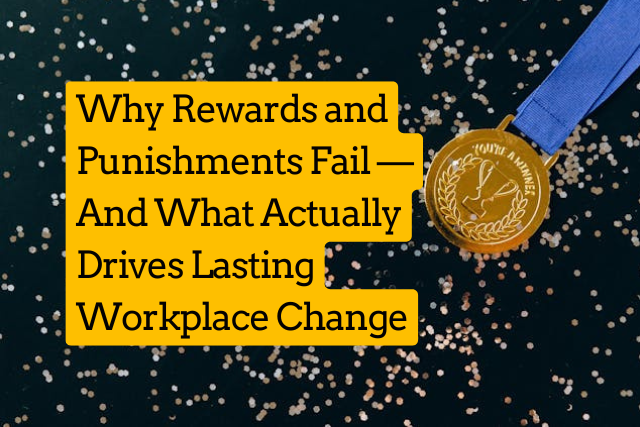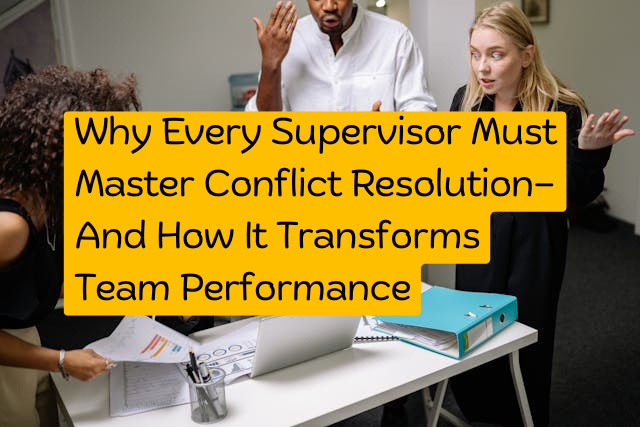The Motivation Myth in the Modern Workplace
Picture this: A top performer misses a target. They’re warned. Another does great—gets a bonus. Seems simple, right? Reward the good, punish the bad, and your team will align like clockwork.
Wrong.
While rewards and punishments have long been the default tools in management’s arsenal, behavioral science shows they rarely lead to meaningful, long-term change. In fact, they can backfire—causing disengagement, short-term compliance, and even resentment.
In this post, we’ll explore why rewards and punishments often fail, and more importantly, what actually works when you want to build a high-performing, motivated, and committed team.
🔍 1. The Problem With Reward-and-Punishment Thinking
🧠 It’s Based on Outdated Models
Rooted in early behavioral psychology (think Pavlov and Skinner), the reward-punishment model assumes people are stimulus-response machines. Do X → Get Y. Don’t do X → Avoid Y.
But modern research shows that human motivation is far more complex, involving emotions, purpose, autonomy, and belonging.
🎯 It Promotes Short-Term Thinking
- Rewards encourage employees to chase only the bonus, not the bigger mission.
- Punishments drive fear-based compliance—not innovation, ownership, or accountability.
When people do the bare minimum to avoid a negative outcome, performance flatlines.
🧱 2. What the Science of Motivation Really Tells Us
📘 Daniel Pink’s “Drive” outlines three core human motivators:
- Autonomy – The desire to direct our own lives
- Mastery – The urge to get better at something meaningful
- Purpose – The yearning to do something larger than ourselves
🔍 The Self-Determination Theory (SDT) adds:
- Relatedness – Feeling connected to others
- Competence – Feeling capable and skilled
💡 These motivators often outperform bonuses and threats when it comes to engagement and behavior change.
💥 3. The Hidden Costs of Rewards and Punishments
⚠️ Rewards Can:
- Undermine intrinsic motivation (“I was doing this because I cared—now I’m doing it for money.”)
- Create unhealthy competition or sabotage between peers
- Promote gaming the system or cutting corners
⚠️ Punishments Can:
- Erode psychological safety
- Breed resentment or passive resistance
- Suppress creativity or honest feedback
Example:
An employee might avoid taking initiative because “last time I tried something new and failed, I got blamed.”
🧰 4. When Rewards Do Work (and When They Don’t)
✅ Rewards Work Best When:
- They are unexpected or symbolic (e.g., a handwritten note or public praise)
- Tied to values, not just output (e.g., collaboration, integrity)
- Used to reinforce an already internally-motivated behavior
❌ Rewards Fail When:
- They become expected or routine (“Where’s my bonus?”)
- They’re the only reason someone performs
- They’re used to manipulate behavior, not recognize contribution
👩🏫 5. A Better Approach: Positive Reinforcement With Autonomy
Instead of using rewards like carrots, use positive reinforcement to:
- Show employees they’re seen and appreciated
- Reinforce behaviors that align with company values
- Allow choice in how goals are met
🔄 Example:
Instead of saying “You hit your sales target, here’s a bonus,” say:
“The way you built trust with that client was exceptional. You’re setting a great example for the team.”
This approach affirms how the goal was achieved, reinforcing positive behaviors over just results.
🧩 6. What Really Changes Behavior: The 5 R Framework
✅ 1. Relevance
Tie tasks to personal goals or growth.
“You’ll be leading this project—it aligns with your career path into leadership.”
✅ 2. Recognition
Offer meaningful praise and feedback.
“You handled that crisis with such calm and clarity—great work.”
✅ 3. Responsibility
Give ownership, not micromanagement.
“You own the timeline—how do you want to structure it?”
✅ 4. Relationships
Foster connection and trust across the team.
“Let’s pair you with someone from another department for a fresh perspective.”
✅ 5. Reflection
Give space to process wins and setbacks.
“What went well? What would you do differently?”
💼 7. Case Study: When Motivation Goes Beyond the Bonus
🔍 Scenario:
A mid-size tech company noticed that despite lucrative performance bonuses, employee engagement was dropping and turnover was rising.
👇 What They Did:
- Replaced individual bonuses with team-based recognition
- Introduced career development conversations quarterly
- Empowered teams with decision-making authority
- Created “thank you walls” to celebrate peer appreciation
🎯 Outcome:
Engagement scores rose 24% in a year. Turnover dropped. Employees began mentoring each other more proactively.
Moral? When people feel valued, trusted, and connected, performance improves—without needing financial carrots.
🧠 8. Coaching vs. Controlling: The Manager’s Role
Great managers coach behavior change, not control it. Here’s how:
| Controlling Manager | Coaching Leader |
|---|---|
| Issues commands | Asks questions |
| Focuses on compliance | Focuses on commitment |
| Punishes mistakes | Deconstructs mistakes |
| Micromanages progress | Trusts process and input |
| Relies on external rewards | Builds internal drive |
Ask:
“What support do you need to succeed?”
Not:
“Why aren’t you meeting your KPIs?”
📘 9. Making Motivation Sustainable: Systems and Culture
To move from behavior correction to behavioral excellence, you need systems that support:
- Regular feedback loops (weekly 1:1s, pulse checks)
- Transparent goal tracking (OKRs, KPIs, dashboards)
- Recognition rituals (team shoutouts, badges, spot bonuses)
- A culture that values learning, not just winning
These systems embed motivation into the environment, so performance isn’t driven by fear or greed—but by purpose.
🛑 10. Break the Habit: Replacing “Do This or Else” Language
Instead of this 👇
“If you don’t hit this deadline, you’re off the project.”
Say this 👇
“What do you need to meet this deadline? Let’s solve it together.”
Language shapes behavior. Choose words that invite ownership, not induce anxiety.
🎯 11. Summary: Rethink Motivation, Rewire Performance
Let’s recap the truth about changing behavior in the workplace:
| Myth | Truth |
|---|---|
| Rewards = Motivation | Only temporarily |
| Punishments improve behavior | Often breed resentment |
| Money drives performance | Meaning, mastery, and autonomy do more |
| One-size-fits-all incentives | Customization matters |
Your people aren’t robots to program—they’re humans to engage.
✅ Conclusion: Build a Team That Performs Because They Want To
In the end, sustainable behavior change doesn’t come from what you dangle in front of people or take away from them.
It comes from how you inspire, support, and connect with them.
If you want long-term performance, build a culture where:
- Success is celebrated
- Growth is supported
- People feel ownership over their work
Because that’s where real performance begins—not at the end of a carrot or the edge of a stick—but in the heart of motivation itself.







